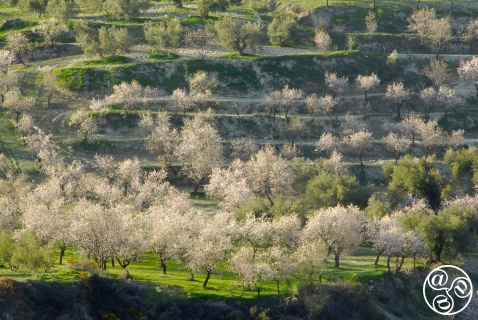
Beautiful almond tree landscapes near Beas de Granada |
|
Villages North East of Granada City
Deifontes is a village in Granada province found alongside a famous waterfall which at times expels more than a thousand litres of water per second. Deifontes found alongside a famous waterfall… More →
Pulianas is comprised of two different areas: Pulianas and Pulianillas. These were originally two independent villages; they united in 1945, through the connection of their respective main roads.… More →
Nívar is a great destination for lovers of rural tourism, sports or photography. It forms part of the Natural Park of Sierra de Huétor; its village centre is 1000 metres above sea level. As a… More →
Jun is located at the edge of the Sierra de Huétor natural park, in the centre of the Granada lowland. The village offers a great combination of natural landscapes and a wealth of heritage and… More →
The proximity of Huétor de Santillán to Granada city does not stop visitors from enjoying the great outdoors; the town is located in the Sierra de Huétor natural park, which gives the village its… More →
This village is the definition of survival - it has been hit by two earthquakes during its long history. The first was the famous Lisbon earthquake of 1755, which destroyed a large part of the… More →
Cogollos de la Vega forms part of la Ruta del Califato and has the perfect combination of natural beauty - the Sierra de Huétor - and culture, in the form of important prehistoric sites.… More →
Calicasas is also known as La Campana Granadina (Bell of Granada) because the bells ringing in the Alhambra Palace in Granada could also be heard in Calicasas. The village has narrow streets,… More →
An old legend still attracts treasure seekers to Beas de Granada where it is said a wealthy merchant once hid his fortune before heading off to war. In reality, it is believed he hid his wealth in… More →
This town in the Sierra de Alfaguara, just outside Granada itself, is the highest in the area, at an altitude of 1050m. Its cooler climate and proximity to the regional capital has made it a… More →
Alfacar is one of the entry points into to the Sierra de Huétor Natural Park. The area surrounding the village is wonderful for trekking and… More →
Parks North East of Granada City
Designated a natural park in 1989, the 12,128ha Sierra de Huétor is only a few kilometres northeast of the provincial capital of Granada, so it is a popular weekend destination for city dwellers.… More →
Designated a natural park in 1989, this rugged and spectacular limestone mountainous region in the north of Granada province, adjacent to the Sierras de Cazorla, Segura y Las Villas Natural Park… More →
In the northeast of Granada province adjacent to neighbouring Almeria is the sparsely populated 53,649ha Sierra de Baza Natural Park, part of the Cordillera Penibética. Its steep slopes are mainly… More →
On the southern edge of the Sierra Castril Natural Park is this spectacular and exceptional rocky outcrop, the Peña de Castril, which looms large over the whitewashed houses of Castril village.… More →
Leaving behind the impressive wooded Sierra de Huétor Natural Park, just a few kilometres east of Granada city, the terrain becomes increasingly dusty and desert-like. Guadix is located in this dry landscape and is unique for its extraordinary area of caves, where a surprisingly high number of the town's inhabitants still live.
A similarly intriguing place is 20km south of Guadix in the foothills of the Sierra Nevada; the village of La Calahorra may be unremarkable in itself, but overshadowing it is the immense bulk of one of Spain's best castles. It hides a remarkable Renaissance interior, fashioned by Italian architects and craftsmen in the early 16th century under the direction of a nobleman linked to the Catholic Monarchs.
Moving further east from Guadix is the Sierra de Baza Natural Park, which has extensive tracts of pine forests inhabited by more wildlife than people. It has excellent views from its barren limestone peaks that are covered with snow in winter. On the border with neighbouring Jaen province and the Sierra de Cazorla is another protected area, the mountainous Sierra Castril Natural Park, with a spectacularly eroded limestone landscape of deep, sheer-sided gorges and waterfalls. Its centre is Castril, a village overlooked by a huge rocky outcrop, topped by a castle, known as the Peña de Castril Natural Monument.
